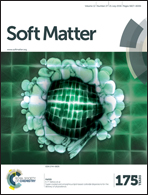The effect of wall depletion and hydrodynamic interactions on stress-gradient-induced polymer migration
Abstract
We generalize our recent continuum theory for the stress-gradient-induced migration of polymers [Zhu et al., J. Rheol., 2016, 60, 327–343] by incorporating the effect of solid boundaries on concentration variations. For a model flow in a channel with periodic slip wall velocity, which can in principle be produced by an electric field in the presence of a sinusoidal wall charge, we obtain theoretical results for the steady-state distribution of dilute solutions of polymer dumbbells using a systematic perturbation analysis in Weissenberg number Wi. We find that the presence of a thin wall depletion zone changes the lowest order solution from second to first in Wi and drastically affects the concentration field far from the depletion layer, due both to a coupling of the second derivative of the velocity field to the concentration gradient, and to convection of the polymer-depleted fluid in this layer into the bulk of the fluid. Additional effects induced by wall hydrodynamic interaction (HI) are assessed by incorporating polymer flux from the wall-HI migration theory of Ma and Graham into our continuum theory. We establish the range of validity of our theory by comparing the theoretical results with Brownian dynamics (BD) simulations: excellent agreement is achieved for relatively small molecules, while the theory breaks down when the Gradient number Gd is greater than 0.5, where Gd is the ratio of polymer coil size to the length scale over which the velocity gradient changes. The BD simulations are also extended to the case of long Hookean chains with numbers of springs per chain ranging from 1 to 32, where it is found that for fixed Gd and Wi, the results are nearly identical, showing that all important phenomena are captured by a simple dumbbell model, thus supporting the continuum theory which was derived for the case of dumbbells. In addition, the Stochastic Rotation Dynamics (SRD) method is employed to evaluate the role of HI on the migration pattern, producing effects consistent with the continuum theory incorporating the wall-migration flux. In general, we demonstrate that the polymer concentrates in drastically different regions of the channel depending on Gd and Wi.


 Please wait while we load your content...
Please wait while we load your content...